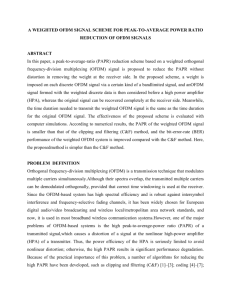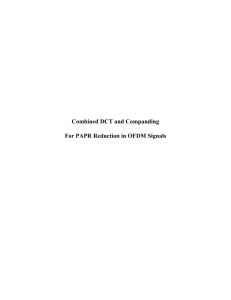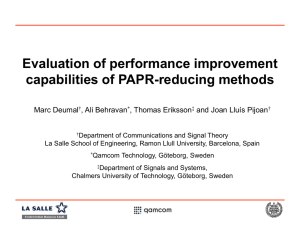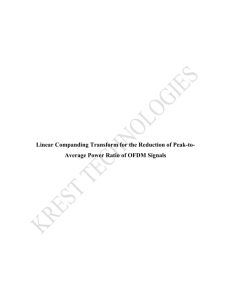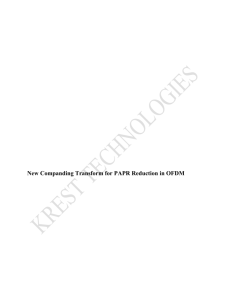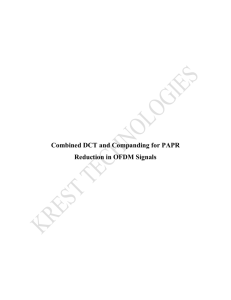A. An Optimized ICF Method
advertisement
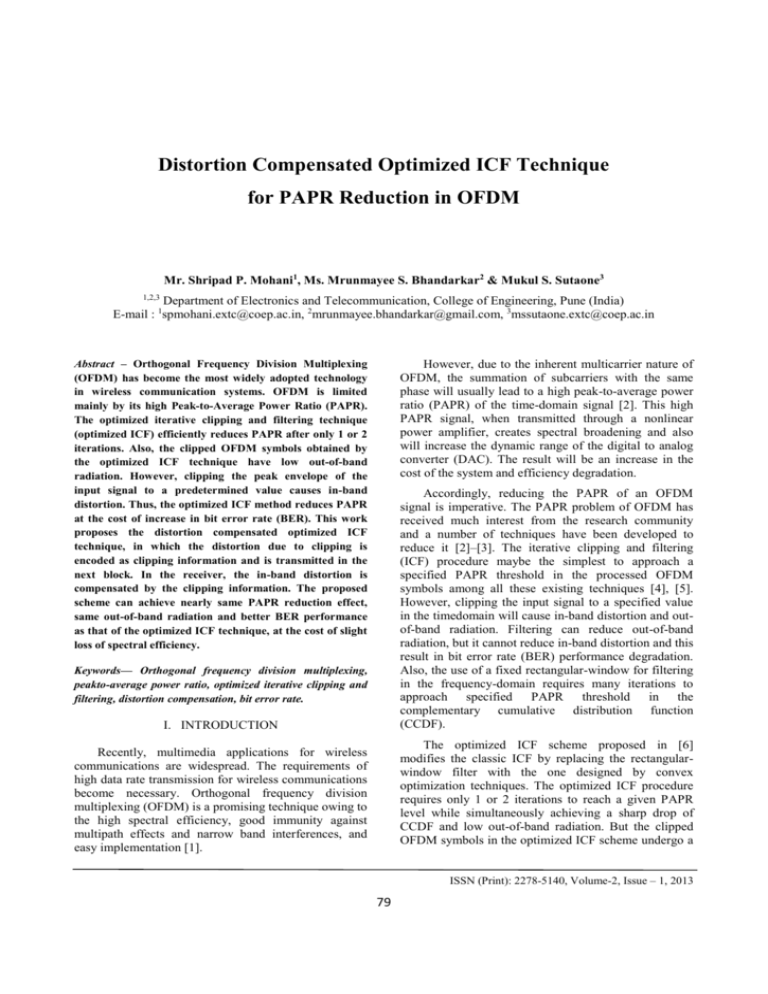
Distortion Compensated Optimized ICF Technique for PAPR Reduction in OFDM Mr. Shripad P. Mohani1, Ms. Mrunmayee S. Bhandarkar2 & Mukul S. Sutaone3 1,2,3 Department of Electronics and Telecommunication, College of Engineering, Pune (India) E-mail : 1spmohani.extc@coep.ac.in, 2mrunmayee.bhandarkar@gmail.com, 3mssutaone.extc@coep.ac.in Abstract – Orthogonal Frequency Division Multiplexing (OFDM) has become the most widely adopted technology in wireless communication systems. OFDM is limited mainly by its high Peak-to-Average Power Ratio (PAPR). The optimized iterative clipping and filtering technique (optimized ICF) efficiently reduces PAPR after only 1 or 2 iterations. Also, the clipped OFDM symbols obtained by the optimized ICF technique have low out-of-band radiation. However, clipping the peak envelope of the input signal to a predetermined value causes in-band distortion. Thus, the optimized ICF method reduces PAPR at the cost of increase in bit error rate (BER). This work proposes the distortion compensated optimized ICF technique, in which the distortion due to clipping is encoded as clipping information and is transmitted in the next block. In the receiver, the in-band distortion is compensated by the clipping information. The proposed scheme can achieve nearly same PAPR reduction effect, same out-of-band radiation and better BER performance as that of the optimized ICF technique, at the cost of slight loss of spectral efficiency. However, due to the inherent multicarrier nature of OFDM, the summation of subcarriers with the same phase will usually lead to a high peak-to-average power ratio (PAPR) of the time-domain signal [2]. This high PAPR signal, when transmitted through a nonlinear power amplifier, creates spectral broadening and also will increase the dynamic range of the digital to analog converter (DAC). The result will be an increase in the cost of the system and efficiency degradation. Accordingly, reducing the PAPR of an OFDM signal is imperative. The PAPR problem of OFDM has received much interest from the research community and a number of techniques have been developed to reduce it [2]–[3]. The iterative clipping and filtering (ICF) procedure maybe the simplest to approach a specified PAPR threshold in the processed OFDM symbols among all these existing techniques [4], [5]. However, clipping the input signal to a specified value in the timedomain will cause in-band distortion and outof-band radiation. Filtering can reduce out-of-band radiation, but it cannot reduce in-band distortion and this result in bit error rate (BER) performance degradation. Also, the use of a fixed rectangular-window for filtering in the frequency-domain requires many iterations to approach specified PAPR threshold in the complementary cumulative distribution function (CCDF). Keywords— Orthogonal frequency division multiplexing, peakto-average power ratio, optimized iterative clipping and filtering, distortion compensation, bit error rate. I. INTRODUCTION The optimized ICF scheme proposed in [6] modifies the classic ICF by replacing the rectangularwindow filter with the one designed by convex optimization techniques. The optimized ICF procedure requires only 1 or 2 iterations to reach a given PAPR level while simultaneously achieving a sharp drop of CCDF and low out-of-band radiation. But the clipped OFDM symbols in the optimized ICF scheme undergo a Recently, multimedia applications for wireless communications are widespread. The requirements of high data rate transmission for wireless communications become necessary. Orthogonal frequency division multiplexing (OFDM) is a promising technique owing to the high spectral efficiency, good immunity against multipath effects and narrow band interferences, and easy implementation [1]. ISSN (Print): 2278-5140, Volume-2, Issue – 1, 2013 79 International Journal of Advanced Computer Engineering and Communication Technology (IJACECT) significant nonlinear distortion degrading the BER performance of the OFDM system. This paper proposes a distortion compensated optimized ICF scheme, which can achieve nearly same PAPR reduction effect as that of the optimized ICF technique, while maintaining the BER performance of the OFDM system. Simulation results demonstrate the effectiveness of the proposed approach. II. SYSTEM MODEL AND PAPR DEFINITION A. OFDM Symbol . . B. PAPR PAPR is defined as the ratio of the maximum instantaneous power to the average power and is related to OFDM constellation reshaping. The PAPR of the time-domain OFDM symbol, x, can be defined as ISSN (Print): 2278-5140, Volume-2, Issue – 1, 2013 80 International Journal of Advanced Computer Engineering and Communication Technology (IJACECT) III. PROPOSED TECHNIQUE Due to use of optimal filter, the optimized ICF procedure requires only 1 or 2 iterations to reach a given PAPR level. Moreover, the clipped OFDM symbols obtained by the optimized ICF method have low out-ofband radiation. A. An Optimized ICF Method An optimized ICF method as described in [6] modifies each OFDM symbol one at a time (See optimized ICF block in figure 1). For convenience, we use c0 and x0 to represent the original (undistorted) frequency-domain and time-domain OFDM symbols, respectively, and c and x for the processed frequencydomain and time-domain OFDM symbols. But these symbols undergo a significant nonlinear distortion, degrading the BER performance of the OFDM system. B. Proposed distortion compensation scheme In the first iteration of optimized ICF method (m = 1), switch K1 is set to 1 and the new OFDM symbol enters the optimized ICF block. Then, both K1 and K2 are set to 2 and clipping and optimal filtering is iteratively performed. In the Max-th (final) iteration, the switches are returned to position 1 and thus the output c is produced. More specifically, the clipping procedure is performed by By making several modifications in the distortion compensation scheme given in [7], we propose a distortion compensation scheme for optimized ICF technique. The block diagram of a baseband OFDM system under the AWGN channel with the proposed distortion compensated optimized ICF scheme is depicted in figure 1. In the first iteration (m =1), switch K1 is set to 1 and the new OFDM symbol enters the optimized ICF block. Then, both K1 and K2 are set to 2 and clipping and optimal filtering is iteratively performed. When both K 1 and K 2 are set to 2, the switch K 3 is kept open. In the Max-th (final) iteration, the switches K1 and K2 are returned to position 1 which produces the output c and the switch K3 is closed to generate the clipping information as explained below. Fig. 2. Information rate comparison for different values of N for the proposed distortion compensation scheme and the distortion compensation scheme given in [7]. ISSN (Print): 2278-5140, Volume-2, Issue – 1, 2013 81 International Journal of Advanced Computer Engineering and Communication Technology (IJACECT) IV. SIMULATION RESULTS In figure 2, the information rate as a function of h for different values of N for the OFDM system with 64QAM modulation and over-sampling factor l = 4 is plotted for the proposed distortion compensation scheme and the distortion compensation scheme given in scheme in [7]. It can be seen from the figure that the information rate of both the proposed distortion compensation scheme and the distortion compensation scheme given in [7] is relatively high for higher ISSN (Print): 2278-5140, Volume-2, Issue – 1, 2013 82 International Journal of Advanced Computer Engineering and Communication Technology (IJACECT) VI. REFERENCES [1] R. van Nee and R. Prasad, OFDM for Wireless Multimedia Communications. Norwood, MA: Artech House, 1999. [2] T. Jiang and Y. Wu, “An overview: peak-toaverage power ratio reduction techniques for OFDM signals,” IEEE Transactions on Broadcasting, vol. 54, no. 2, pp. 257–268, Jun. 2008. [3] S. H. Han and J. H. Lee, “An overview of peakto-average power ratio reduction techniques for multicarrier transmission,” IEEE Wireless Communication Magazine, vol. 12, no. 2, pp. 5665, 2005. Fig. 5. Out-of-band radiation comparison of OFDM signals through SSPA: optimized ICF, proposed scheme, and none-processed. [4] J. Armstrong, “Peak-to-average power reduction for OFDM by repeated clipping and frequency domain filtering," Electronics Letters, vol. 38, no. 5, pp. 246-247, Feb. 2002. V. CONCLUSIONS [5] L. Wang and C. Tellambura, “A simplified clipping and filtering technique for PAR reduction in OFDM Systems," IEEE Signal Processing Letters, vol. 12, no. 6, pp. 453-456, June 2005. [6] Y.C. Wang and Z.Q. Luo, “Optimized Iterative Clipping and Filtering for PAPR Reduction of OFDM Signals,” IEEE Transactions on Communication, vol. 59, no.1, pp 33-37, Jan. 2011. [7] Yongpeng Wu, Wenjing Wang and Xiqi Gao, “Distortioncompensation scheme for PAPR reduction of OFDM signals,” IEEE Conference on Wireless Communication, networking and Computing, pp. 1-3, 2009. [8] M. Grant and S. Boyd, “CVX: Matlab software for disciplined convex programming (web page and software)." [Online]. Available: http://stanford.edu/ boyd/cvx, Oct. 2008. The optimized ICF method can alleviate the high PAPR problem in OFDM systems, but causes BER performance degradation. In this paper, the distortion compensated optimized ICF scheme is proposed to mitigate the clipping effect. Our investigations, performed by considering 256 subcarrier OFDM system with 64-QAM modulation and oversampling factor l = 4, have shown that this technique can achieve nearly same PAPR reduction effect, same out-of-band radiation and better BER performance than that of the optimized ICF technique. This is achieved at the cost of slight loss of spectral efficiency. It is also shown by simulations that the information rate of our distortion compensation scheme is better than that of the distortion compensation scheme given in [7] for the given value of N. The information rate of the proposed scheme is relatively high for higher values of N. ISSN (Print): 2278-5140, Volume-2, Issue – 1, 2013 83

